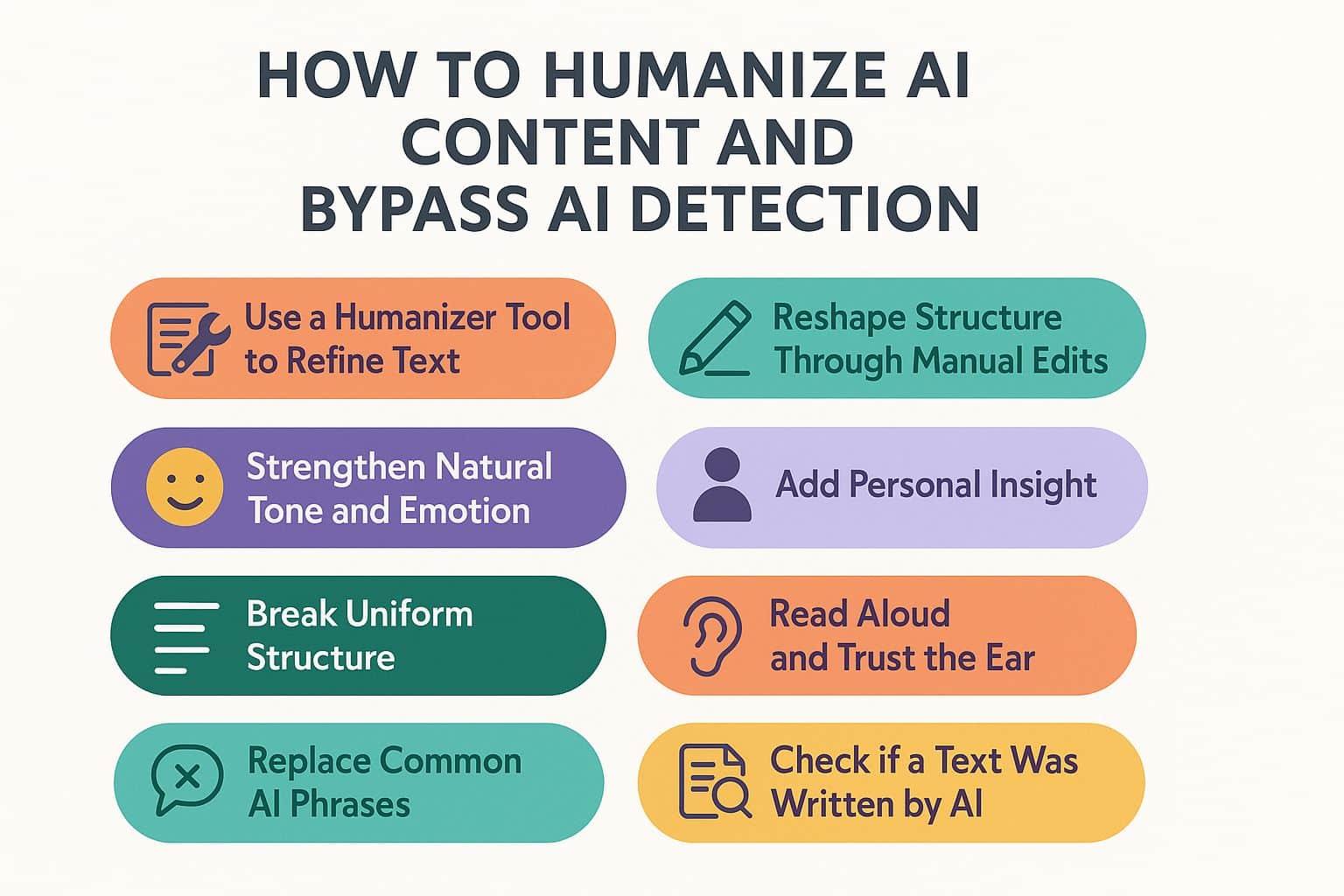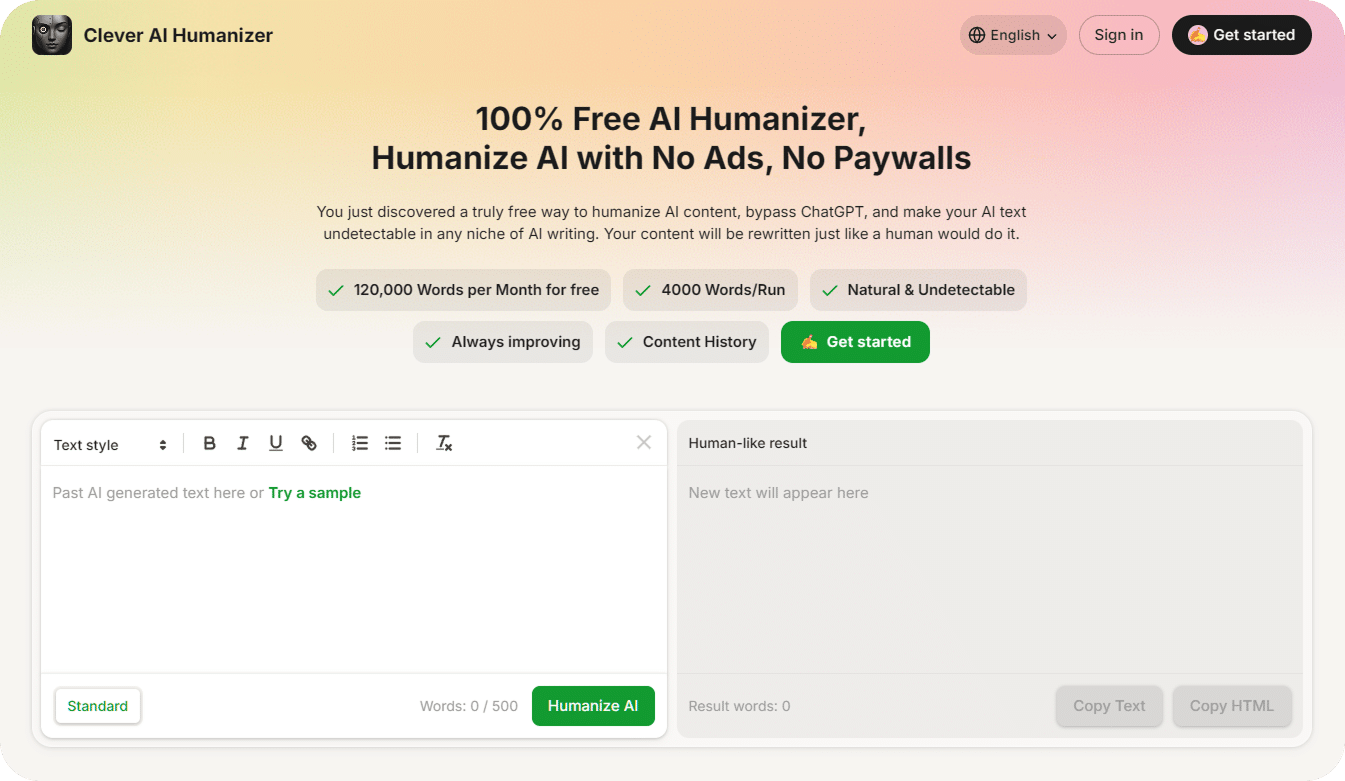AI-generated content is easy to create but just as easy to detect. When you post unedited machine text, it often gets flagged by AI detection tools, penalized in search results, or seen as inauthentic by readers. The best way to avoid AI detection in writing is to add a human voice, apply manual edits, and keep a natural tone that feels original.
Our guide explains how detectors work, how to check if content comes from AI, and how to refine your text so it reads naturally. You’ll also find clear methods to make your writing sound authentic and undetectable to automated systems.
What Is AI Detection and Why It Matters
The flood of AI-generated content has led to the rise of so-called AI detectors, but their accuracy remains a debate. Many users share that even old human-written articles can appear as flagged as AI or partly AI. These systems judge text by rhythm, tone, and word order, not by thought or intent. When sentences sound too smooth or the structure feels too even, detectors often mistake precision for automation.
This uncertainty turns into risk – marked content loses trust and reach.
What is AI-Generated Content
Modern tools can create full articles within seconds. They form sentences by prediction, not real insight, which often leaves the result without depth or purpose. This kind of machine text, known as AI-generated content, depends on probability rather than human thought or emotion.
Most readers overlook these signs, yet AI detection tools detect them easily. To humanize AI-generated text to avoid detection, an author should add personal tone, real context, and irregular rhythm. These elements make AI text more human and keep the message believable.
The path to how to avoid AI detection in writing starts with knowing what exposes automated work and what defines a true human voice.
Why AI Content is Detectable
Text created by machines often shows clues that reveal its source. Sentences hold the same rhythm, phrases repeat across sections, and transitions feel too balanced. A casual reader may miss these details, but detectors spot them fast.
Detection tools measure two core factors – perplexity and burstiness. Low scores in both mean the text appears too regular and too predictable, which points to an automated origin.
Writers share real cases where fully human essays were marked as AI. This shows that detectors often fail.
How to Check If Your Content Is AI-Generated
Before release, it helps to check if the content is AI-generated. Many writers use quick tests to confirm that their text feels natural and passes detector review. Modern AI detection tools measure tone, rhythm, and structure to find traits common in automation.
Main AI detection tools to check your text:
- Originality.ai. Strong option for SEO and long texts; highlights signs of machine authorship with precise scores.
- ZeroGPT. Free and simple to use; reveals robotic rhythm and helps make text not AI detectable.
- Copyleaks Detector. Reliable service that shows AI probability in clear percentages.
Most AI detectors show a numeric score – a percentage that reflects how much of the text appears machine-written. A result near 0% suggests a natural tone, while a higher score points to possible automation. These tools highlight patterns or sections that feel too precise or repetitive.
How to Humanize AI Content and Bypass AI Detection
If a text feels too smooth or too repetitive, detectors may flag it as machine-written. The goal is not to hide automation but to shape it – to humanize machine-written content and make it sound real.
Now, let’s move to methods that help make AI content undetectable while keeping clarity and authenticity.

1. Use a Free Humanizer Tool to Refine Text
Writers often look for a simple way to restore rhythm and natural tone after machine drafts. The easiest method is to use a humanizer to avoid AI detection, for example, Clever AI Humanizer, which, in our view, is the best tool to humanize AI text for free (without any subscriptions).

You paste your text, press one button, and the result sounds far more human. It may not reach a perfect 0% on every detector, but in our experience, it quickly drops a full 100% AI mark to a far more balanced result while keeping the meaning clear. The tool fixes tone, word flow, and structure without loss of your personal style.
Tip: Use a humanizer for quick tone repair, then add your own touch for full authenticity.
2. Reshape Structure Through Manual Edits
AI text often feels too even and too safe. Sentences follow predictable patterns, and paragraphs share the same length. To break this uniform structure, use manual editing to shift rhythm and pace. Mix short and long sentences, cut one transition, or start a new idea abruptly. Each irregular move adds personality and keeps the reader’s attention.
A natural flow should feel uneven, alive, but not chaotic. That subtle imbalance shows a human hand, not a programmed sequence.
Tip: Review one paragraph at a time and change its rhythm or word order until it sounds unpredictable. This process helps humanize text to avoid AI detection and restore genuine tone.
3. Strengthen Natural Tone and Emotion
A flat or overly formal voice often exposes automation. Readers search for rhythm and emotion that change with context. A natural tone builds that balance and gives the page warmth.
Shift between calm explanation and personal reaction. Add moments of curiosity, irony, or doubt. These turns make AI text more human and transform sterile facts into genuine communication.
Detectors treat emotional movement as proof of human control. When tone reflects intent and feeling, no tool can easily classify the text as mechanical.
Tip: After each paragraph, test whether the tone feels alive. If every line sounds the same, add a small reaction or hint of mood to humanize AI text and bypass AI detection and authentic writing.
4. Add Personal Insight and Show a Clear Human Voice
Facts without emotion sound mechanical. A reader connects through detail and tone, not structure. To humanize AI-generated text to avoid detection, we recommend that you add recollections, real observations, or lessons from your own life. These details show depth and form rhythm that no algorithm can copy. One personal example from you adds warmth and unpredictability traits that every detector fails to read.
Tip: Use one honest opinion or short story to create authentic writing and reveal a natural human voice.
5. Break Uniform Structure to Create a Human Rhythm
Perfect symmetry always betrays automation. Machines build paragraphs that follow an identical length and order. This uniform structure may look neat, but it lacks the random flow of real thought. To get past the AI detector, loosen the pattern. Mix sentence sizes, add an abrupt stop, or ask a short question to reset the pace.
Unpredictable rhythm mirrors how people think and speak. It keeps attention and breaks the predictable patterns that detectors measure. A little disorder helps make AI content undetectable because the text no longer fits the precise logic of a generator.
Tip: Reread one section and check its shape on the page. If every line feels equal, shorten one, stretch another, or move a phrase to the front. Variety creates life, and life always proves authorship.
6. Read Aloud and Trust the Ear
The ear notices what the eye misses. When a paragraph sounds too flat or too cold, it often shows traces of automation. Read the text aloud to reveal monotone rhythm, repeated words, or awkward transitions. After that, fix the lines – shorten one, divide another, or add a pause to bring back a natural sound.
This step serves as a short review of the text for flow and correctness. A person reads the material carefully to confirm that rhythm, grammar, and tone feel human. Such attention helps make AI text more human and removes signs of mechanical structure.
Tip: After each section, read it out loud. If the passage feels too even or emotionless, adjust the pace or tone slightly to humanize the text to avoid AI detection and preserve a real human voice.
7. Replace Common AI Phrases That Reveal Automation
AI text often repeats the same polished expressions. Phrases such as “unravel the mystery,” “in the realm of,” or “a true game-changer” appear so often that they look artificial. A short manual check helps remove these patterns and restore a more human rhythm.
Writers share useful examples of such phrases in the thread What AI-isms give away AI-generated writing, where users post words and clichés that detectors often flag. These examples help refine tone and replace mechanical order with natural flow.
Tip: Remove common phrases and add short, direct words.
8. Check if a Text Was Written by AI Before Release
Even after careful edits, a text may still show traces of automation. Writers can use tools that help check if a text was written by AI, compare results with real examples, and spot patterns that look unnatural. The discussion there helps identify mechanical rhythm, repeated tone, or unnatural balance that tools often miss.
Writers who read the feedback often spot weak areas faster than with automated detectors. The process strengthens awareness of tone and structure, helping any author sound authentic and confident.
Tip: Use this forum as a final checkpoint. Honest community feedback often shows what software fails to detect.
Last Tips
Before we wrap up, we want to mention a couple more things that can make writing sound less like AI.
The best way to avoid detection starts before the first draft appears. Most issues arise at the generation stage, when a writer accepts the first result from GPT or Gemini without revision. Stronger outcomes come from clear prompts that define text from the start.
Avoid short or vague prompts like “Write a 1000-word article about AI detection.” Instead, give precise direction. Ask for a confident tone, balanced rhythm, and natural emotion. A clear request at the beginning creates text that already feels human and needs fewer edits later.
Check early paragraphs and adjust words before the model expands them. Replace weak transitions, cut long chains of ideas, and remove overly formal phrases. This habit helps you keep control of style and prevents the text from sounding mechanical.
Real quality comes from awareness, not correction. A writer who shapes ideas early leaves fewer signs of automation and more proof of real voice – the kind of tone that no detector can label as artificial.
